-
Get the Most Out of Your RV Battery
Les Schwab is here to help you get the most out of your RV batteries, whether you need to recharge, replace, or you have questions about the best battery setup for your needs. Getting a charge out of your RV and trailer adventures begins and ends with the right battery.
Keeping Your Batteries Charged
During the winter months and long stretches where the battery will not be used, be sure to take your batteries out of your RV or trailer and hook them up to a trickle charger. These small units plug directly into a 110-volt outlet and allow you to keep your batteries fresh and fully charged until you’re ready for your next outdoor adventure.
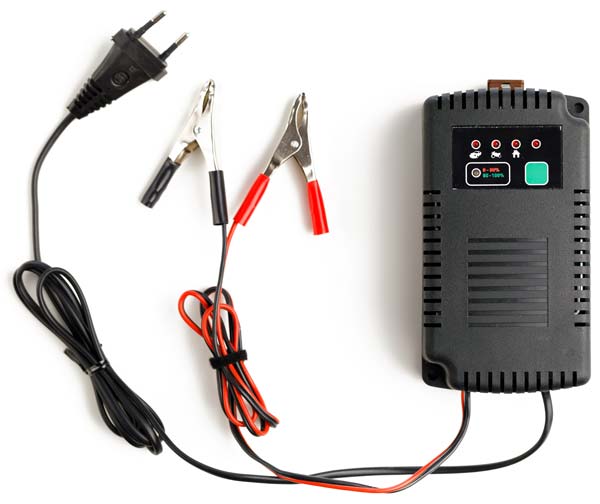
Les Schwab Tip: It’s a good idea to get your RV and trailer batteries fully charged every year. If your 12-volt battery reaches just 11.2 volts, it’s considered completely discharged. Your local Les Schwab does free battery charging and visual inspections.
12-volt vs. 6-volt
Almost every RV and trailer will come equipped with one or even two 12-volt batteries running in parallel. There’s nothing wrong with this setup. The battery boxes and enclosures are built for those size of batteries. But with a few changes, and a switch to a series of 6-volt batteries, you might get more reserve capacity, which means you can draw power for a longer amount of time between charges.
The benefits of a standard 12-volt battery include the uniformity (your RV or trailer will most often come with 12-volt batteries), cost (12-volt batteries can be less expensive), and simple installation. However, 12-volt batteries may not recharge as quickly as a 6-volt. When it comes to power and longevity, it can take up to three 12-volt batteries running in parallel to match the amp hours in a series of two 6-volt batteries.
Other benefits of running 6-volt batteries in series include a larger amp hour capacity (the amount of time you can use the battery), and a longer battery lifespan. The only real downside is that there may be size differences. 6-volt batteries can sometimes be taller. This can require changes to your battery box or battery storage area.
Les Schwab is Your Battery Expert
Stop by your local Les Schwab before you head out on your first RV or trailer outing of the season. Our team of professionals is here to ensure your batteries are properly charged and installed correctly with our best-in-the-business warranty.
-
The Real Reasons Your Car Battery Keeps Dying
Modern car batteries are designed to start your car or truck, run all of the electronics, and maintain the vehicle’s computer memory. But over time, batteries do eventually run out of juice — sometimes way before their time. Here are the real reasons your car battery dies, or keeps dying, and what you can do to get the most out of it.
Les Schwab Tip: If your battery seems to die while you’re driving, it could be an issue with your vehicle’s electrical components or charging system. You might need to visit your mechanic or stop by Les Schwab so we can double-check your battery and connections.
Why Your Car Battery Keeps Dying
While car batteries slowly die over time, high heat, brutal cold, excessive use of vehicle accessories (after-market equipment), and other mechanical issues can shorten the life of even the toughest battery. Read How Your Battery Works to understand why batteries die over time. The top six reasons batteries die include:
Lights left on. That can be your car headlights, dome light, light in the glove box, or trunk light. Even vanity mirror lights can drain a battery if left on overnight.
Parasitic draw. Your car battery can drain over time from stereo components (subwoofers), phone chargers, and anything you leave plugged into vehicle outlets that continue to draw power from the battery after the car is turned off. Other power drains include interior and below-vehicle LED lights.
Loose or corroded connections. A loose connection can damage the battery and/or drain it. Check your battery cables often for corrosion. If you find any, clean it off to ensure a tight connection.
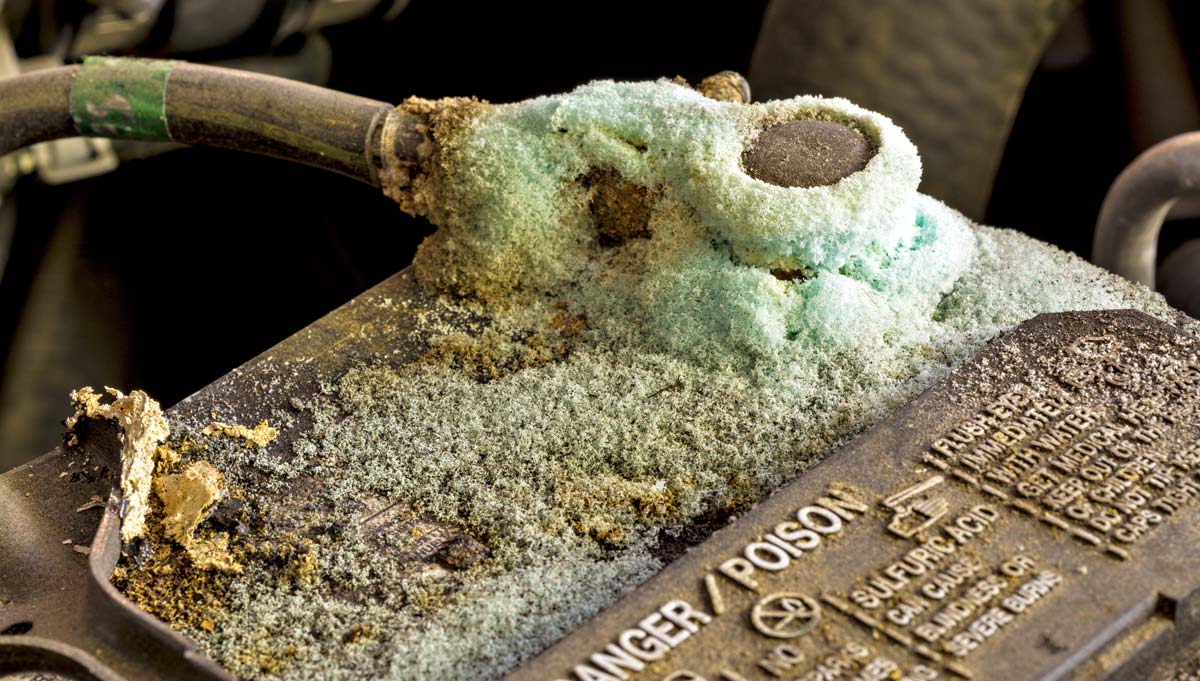
Excessive heat and cold. It seems like batteries die most often in the winter. You go to start your car, and the battery just cannot turn the engine over. But it’s not the cold that kills most batteries. Hot summer months can deteriorate your battery. Then, you notice that lack of power in the winter. To help avoid damage to your battery from heat, park your vehicle in a garage or under a shelter on hot summer days.
The alternator has issues. Once your car is started, the alternator helps it stay charged. But if the alternator is going bad or the alternator belt is slipping, it might not recharge your battery.
Quick trips or leaving your car parked too long. Too many quick trips (less than 15 minutes in length) can degrade a battery. Additionally, letting a car sit for too long without being started (weeks or months) can cause issues.
Age. Batteries don’t last forever. How often you start your vehicle, how far you drive, the health of your alternator, the hot and cold conditions in your region, and more can affect the lifespan of your battery.
How to Prevent Your Battery From Draining, and What Causes It
The life of your car battery depends on where you live, how much you drive, and more. If your car needs a new battery, Les Schwab is here to help with batteries for everything you drive. Here are a few tips to help keep your battery from draining.
Unplug Extra Accessories: Known as parasitic draw, your car battery can drain from stereo components and phone chargers that continue to work when the car is turned off. Also, be on the lookout for glove-box lights, trunk lights, and interior lights that remain illuminated.
Take a 15-minute drive: At least once per week, take your car for a short drive. As long as your alternator is working correctly, this will help maintain the battery state of charge.
Don’t leave your headlights on: Turn the switch to the “off” position, even if your lights go off automatically.
Avoid deep discharging: Don’t leave the lights on or the stereo going while the car is turned off. This can result in a dead battery.
Tighten and Clean Battery Connections: If your battery terminals are loose or corroded, they can drain or damage the battery. It could also cause your car to stall. If you do find corrosion, it’s easy to clean with a stiff-bristle brush (an old toothbrush works great), and a mixture of one part baking soda to three parts water. With a little elbow grease, the corrosion will vanish. Just be careful not to get any of the baking soda/water mixture in your battery or on other parts of your engine or vehicle.
What to Do When Your Battery Dies
Dead batteries happen to everyone. It can be frustrating, especially when you’re late for work. Having a set of jumper cables or a jump starter can get you going again. We’ve put together a jump-start how-to video to help get your car or truck started.
When you’re a Les Schwab customer, you’re welcome to call us during regular business hours. If we’re available, we may be able to drive to your location and give you a jump start.
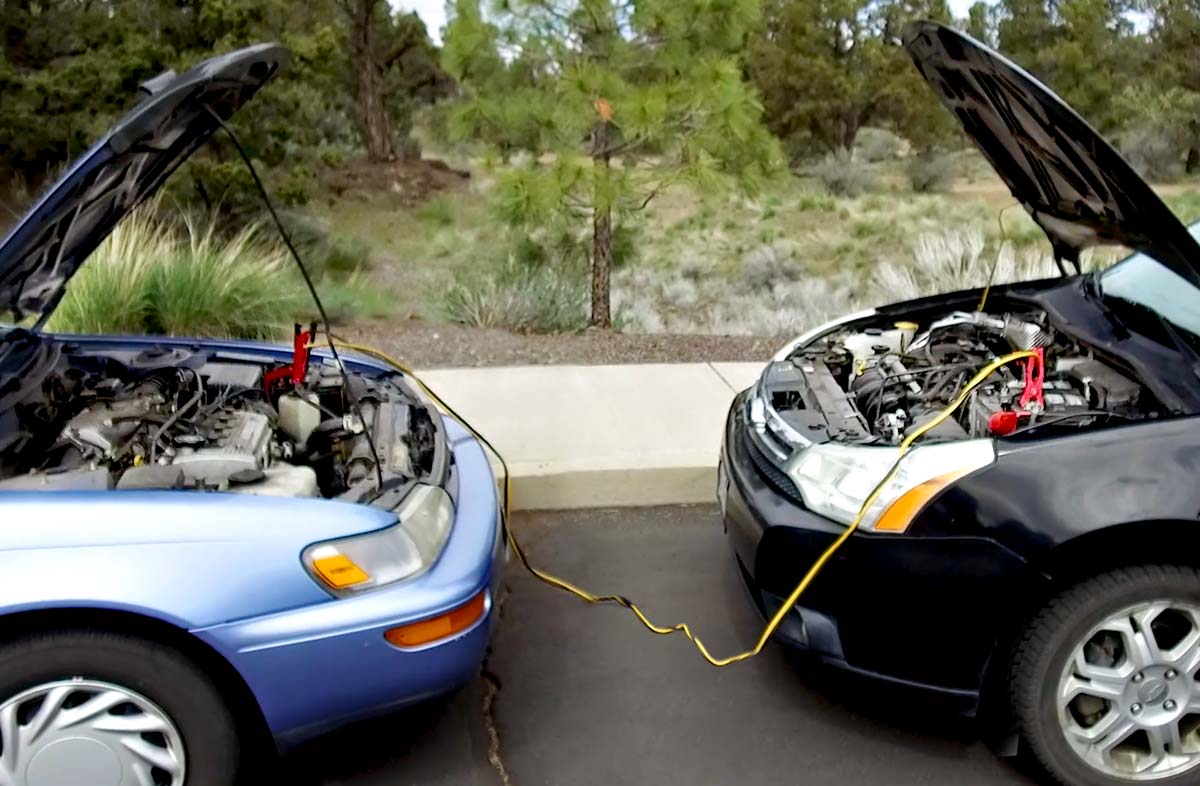
Need More Help? Give Us a Visit!
Les Schwab gets a charge out of checking your battery. Come on by and we’ll perform a free inspection. Whether it just needs to be recharged or if you need a new battery, we can help, including new batteries for most vehicles.
-
Need a New Battery? Start Here.
If you’re wondering how often you should change your car battery, how long it takes to change a battery, or why your battery died suddenly without warning, the answer might not be what you’re expecting.
Leaving Battery Installation to the Professionals
At one time, removing your vehicle’s old, dead battery and installing a new one was an easy bit of car maintenance. Today’s vehicles are more complex. And, so are today’s automotive batteries. Vehicles from the mid-90s may require special equipment and care when changing a new battery. In fact, don’t be surprised if you’re not sure how to even unhook your car battery.
The reason for that complexity? Most of today’s cars and trucks are packed with computers and other special electronic equipment that rely on a continuous power supply. Incorrectly changing out a battery can affect your radio presets, security system, power windows, as well as your air conditioning and heating controls.
More importantly, a loss of power during battery installation can also cause unseen issues to your vehicle’s operating systems. Because today’s automotive computers adapt while you drive, a loss of power can negatively affect systems that regulate your transmission, engine efficiency, and battery charging.
Batteries aren’t always under the hood of today’s vehicles. They may be located on the inside of your vehicle, which require a specific battery that needs ventilation to keep harmful gasses out of your vehicle’s interior.
Start at Les Schwab
If you think you have a drained battery, head over to a Les Schwab near you. Our battery installation teams use the latest equipment to maintain power to those sensitive systems during the battery installation process. We also use the latest in diagnostics and testing equipment to check the overall health of your battery, charging and starting systems.
Know the Nearly Dead Battery Warning Signs
It doesn’t take a lot of power to start today’s vehicles, which means you might not get the telltale slow-start associated with a dying battery. You might not even notice your battery is going dead until it’s too late.
Things that can contribute to a drained battery include extreme hot and cold weather, how often and far you drive each day, how long your vehicle is parked in one location without being started, and if you have any aftermarket equipment installed such as a stereo or auxiliary electronics and lighting. See our article How Your Auto Battery Works to understand why batteries die over time and how a car battery recharges.
LesSchwab Tip: Because the signs of a weak battery might not be as noticeable and batteries rarely die at a convenient time, the professionals at your local Les Schwab can check your battery condition for free — even if it isn’t dead.
While it’s common to experience a dead battery in the winter, it’s actually the hot, summer months that cause most battery wear and tear. This is due to an increase in the chemical reactions inside the battery during hot days. When the weather gets cold, that damage is more likely to cause battery failure.
Enjoy up to a Seven Year Battery Warranty
Get a jump on your next battery at your local Les Schwab. We carry automotive batteries for cars, pickup trucks, SUVs, crossovers, RVs, and more. We’ll help you find the best battery for your vehicle and get you quickly back on the road. Our professional installation takes the guesswork and worry out of buying a new battery. Learn more at Les Schwab Tire Centers.
-
How to Jump-Start a Car
Starting your car is a rather easy process, unless the battery has completely failed. Then, you’re not going anywhere. Luckily, jump-starting your vehicle is also easy. All you need are the right tools and know-how to get it done right. Here’s what you need to know.
Common Reasons for a Battery Dying
We’ve all left the lights on in a car or truck only to find a dead battery a few hours later. Thankfully, that doesn’t necessarily mean the battery has failed or reached the end of its life. It may be possible to jump-start it and enjoy years of uninterrupted use. To get the most out of your battery, try to avoid a few battery-killing scenarios.
Deep Discharging: leaving the lights on or the stereo going while the car is turned off. This can result in a dead battery or a clicking noise when you try to start the vehicle.
Hot Summer Days: Hot, summer months can deteriorate your battery over time. You simply notice it in the winter when it takes more power to crank over a cold engine — power the deteriorating battery doesn’t have. If you can, store your vehicle in a garage or under a shelter on the hottest days.
Corroded Connections or Cables: Check your battery cables often for corrosion. If you find any, clean it off to ensure a tight connection.
Les Schwab Tip: The professionals at your local Les Schwab can check your battery for free – even if it isn’t dead. We may be able to recharge it at no cost if it’s still in good condition.
Must-haves for Jumping a Car Battery
Jumper Cables or a Jump Starter: Jumper cables come in various lengths. The ends of the cables include red and black alligator clips made of copper. To jump-start a car, these clamps attach to the leads of the dead battery and to the vehicle that will help jump-start the dead car or truck. See below for proper procedures. Jump starters come with a smartphone-sized 12-volt battery and a set of red and black cables and clips. These attach to the battery of the dead vehicle and quickly jump-start it with a burst of power.
Gloves: A simple pair of rubber gloves can help protect your hands from corrosive battery acid and other harsh chemicals. Keep a pair with your jumper cables or jump starter.
A Vehicle With a Working Battery (If Using Jumper Cables): To successfully jump-start a vehicle, you’ll need another car or truck with a working battery.
Jumpstarting Your Car: What Are the Steps?
When you have the right tools and know-how from the pros at Les Schwab, jumpstarting your car is easy.
Line up the front of your vehicles and open both hoods.
Take the key out of the ignition in the car with the dead battery. The other vehicle should not be running.
Untangle your jumper cables.
On the dead battery, hook up the red or positive clamp to the positive post on the battery.
Hook the red clamp on the other end of the jumper cables to the positive post on the good battery.
Important: Be sure the black clamps do not touch the red clamps.
Attach the negative or black cable to the good battery. Then connect the other end of the black cable to the negative post on the dead battery. You can also attach it to a piece of solid metal in the engine compartment.
Important: Keep your jumper cables away from engine fans or hot engine components.
Start the vehicle with the working battery and let it run for a few minutes.
Now, try starting the vehicle with the dead battery. If it starts, let it run for a few minutes. If not, allow the car to charge for another minute before another attempt.
To remove the cables, start with the black cable on the previously dead car, then remove the black clamp off the starter car. Finally remove the red from the newly jumped vehicle, and then from the other car or truck.
Les Schwab Tip: Once a car is successfully jumped, you’ll want to go for a short, 30-minute drive. This will give the alternator a chance to recharge your battery, if the alternator and/or battery are in proper working order. If it does not hold a charge, bring it in to Les Schwab for a quick check.
How to Prevent Your Battery From Draining?
The life of your car battery depends on where you live, how much you drive, and how often you start your vehicle. But you can also help prevent it from draining with a few tips.
Unplug Extra Accessories: Known as parasitic draw, your car battery can drain over time from stereo components (such as subwoofers), and phone chargers that continue to work when the car is turned off. Also, be on the lookout for glove-box lights, trunk lights, and interior lights that remain illuminated when the vehicle is off.
Take a 15 Minute Drive: At least once per week, take your car for a short drive. As long as your alternator is working correctly, this will continually recharge your battery.
Don’t Leave Your Headlights On: Turn the switch to the “off” position, even if your lights go off automatically.
Tighten and Clean Battery Connections: If your battery terminals are loose or corroded, it can cause your car to stall. It could also damage the battery.
Les Schwab Gets a Charge Out of Checking Your Battery
With today’s modern vehicles, it can be difficult to tell if your car battery is going dead until it’s too late. Come by your local Les Schwab Tires for a free inspection of your car battery. We carry new batteries for most vehicles, and offer recommendations to keep you from getting stranded.
Shop for Batteries -
Batteries for Anything You Drive
Les Schwab is well known for having the West’s largest selection of tires. Here are four reasons to come to us for batteries as well.
1. Vast Selection
We have an inventory of quality batteries to power just about anything that rolls:
- Cars, light trucks and SUVs
- Commercial vehicles and heavy-duty trucks
- Motorcycles
- Motorhomes/RVs, fifth-wheels and other campers
- Boats, including personal watercraft
- Off-road vehicles (four-wheelers/quads and side-by-sides)
- Farm tractors and equipment
- Golf carts
- Lawnmowers
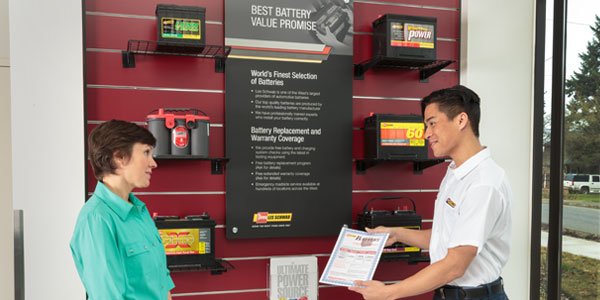
2. More for Your Money
What we say about tires also goes for our batteries: If we can’t guarantee it, we won’t sell it. Our best-in-the-business battery warranty includes a replacement program. We’ll replace standard batteries that are deficient absolutely free for a period between 12 to 24 months, depending on the battery. For motorcycles, golf carts and the like we provide replacements for failed batteries up to six months after purchase. The period for RV, commercial and marine battery replacements extends for one year.
And if your battery fails any time before its expected life after that, we'll refund you the difference. For some batteries, that can mean coverage extending up to seven years.
You’ll also get free auto battery and charging system inspections with your purchase. And you can stop by for a free battery charge at any Les Schwab whenever you want.
3. Expert, Friendly, World-class Service
Our technicians are equipped with state-of-the-art battery diagnostic tools and are well trained in batteries and charging systems. A problem you suspect is being caused by your battery may actually be something wrong elsewhere in the charging system. (Read more.)
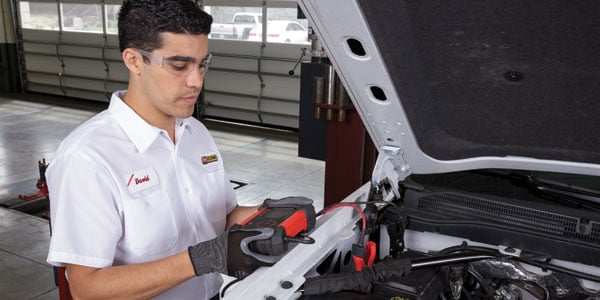
We check any vehicle battery charge for free, whether you bought it from us or not. We’ll give you an honest answer on whether you need a new battery. If you do, one of our service techs will help you decide what battery is best for the job, the vehicle and your budget. Then we’ll install it quickly so you can get on your way without delay.
4. Hundreds of Locations
You can buy, get service on or redeem a warranty for Les Schwab batteries at any of our 480-plus locations across the West. Not sure if you need a new auto battery? We’ll check your battery’s charge while you wait — for free.
For a quality battery backed by a great warranty, come to a Les Schwab Tires near you.
Shop for Batteries -
Starting Problems? How to Tell If It’s the Battery or Alternator
Nothing is worse than getting into your gas- or diesel-powered car or truck, hitting the ignition and going nowhere. Sometimes the issue can be the battery. On the other hand, a failing car alternator will cause your vehicle to shut off soon after you get it started because it’s not recharging the battery. Here are the signs and symptoms of a bad battery or car alternator and how to determine which one is causing issues.
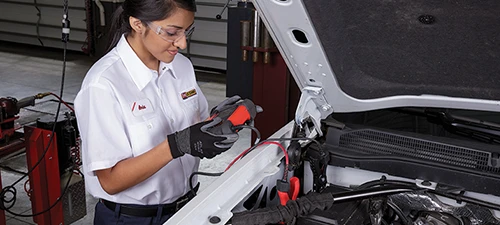
Signs & Symptoms of a Bad Battery
There are some telltale signs of a bad battery. Look for these issues when your car is hard to start, starts inconsistently, or there’s no sound or light on when you hit the ignition.
- Dashboard and interior lights are dim
- Windshield wipers are slow or barely move at all
- Electric windows slowly open or close
- Battery and/or cables are corroded
- Radio won’t turn on
- Swollen battery
You could have a bad battery if the cranking of the engine is sluggish, there’s no sound or interior lights when you try to start the vehicle, your car starts inconsistently, or you can start it with jumper cables but the vehicle will not start again after being shut off. A loose or corroded connection can also cause issues. Not sure? Get to Les Schwab and our pros will take a look and share some options.
How to Tell if Your Battery Is the Problem
If jump-starting works, then it’s probably your battery. The question then is, how old is that battery? If it has been starting your car or truck for more than four years, it could just be at the end of its lifespan. But a battery can also be drained when the lights are left on when the car isn’t running. The pros at Les Schwab have the tools needed to tell the difference and make recommendations.
Schedule A Free Battery Check Schedule A Free Battery Check 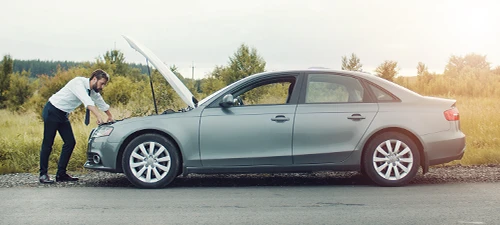
Signs & Symptoms of a Bad Alternator
Gas and diesel-powered vehicles use an alternator to keep the battery charged and run all of the electric systems, such as your radio, windshield wipers and comfort controls. Essentially, the alternator is a small generator that creates electricity from a belt directly connected to the engine. As long as that alternator is creating electricity and the battery is good, your car should start and stay running. If the vehicle won’t crank or start but the headlights are still working, look to problems with the starter or other parts of the engine.
How to Tell if Your Alternator is the Problem
While it can be difficult to tell if your alternator is creating electricity without a lot of specialized tools, there are some signs to watch for:
- Trouble starting the vehicle
- Frequent stalling after you’ve started your vehicle
- Squealing sound coming from the engine that gets louder when you use the heater or sound system (this may be your alternator bearings)
- Interior and exterior headlights that seem to dim and brighten
- Check-engine or battery indicator light illuminated on your dashboard
- Vehicle immediately stops running after a jump start
Here’s a quick way to diagnose your alternator: Get the vehicle started (if possible). Then turn on your radio and tune to a low number on the AM dial. Finally, rev the engine. If you hear a whine or the sound goes fuzzy when you hit the gas, your alternator is probably failing.
Schedule A Free Battery Check Schedule A Free Battery Check Can You Drive with a Bad Alternator or Battery?
It is possible to drive with a bad alternator or battery. But you probably won’t get far. With a bad battery, you’ll be stuck the next time you go to start your car. A bad alternator will quickly deplete your car battery and could cause your vehicle to stall at any time. Even while you’re driving.
To avoid being stuck on the side of the road or someplace you don’t want to be, get a free battery and alternator inspection at Les Schwab. If it’s the battery, we’ll help you choose the right one for your vehicle. If it’s the alternator, we’ll make recommendations and help plan your next steps.
What’s the Purpose of Your Car Battery & Alternator
An auto battery supplies an initial electric charge that travels through the starting system on both gas and electric vehicles. Once a gas- or diesel-powered vehicle is running, an alternator sends current back to recharge the battery as you drive. It supplies power for your car’s electronics when you’re underway and makes sure the right amount of charge goes back to the battery.
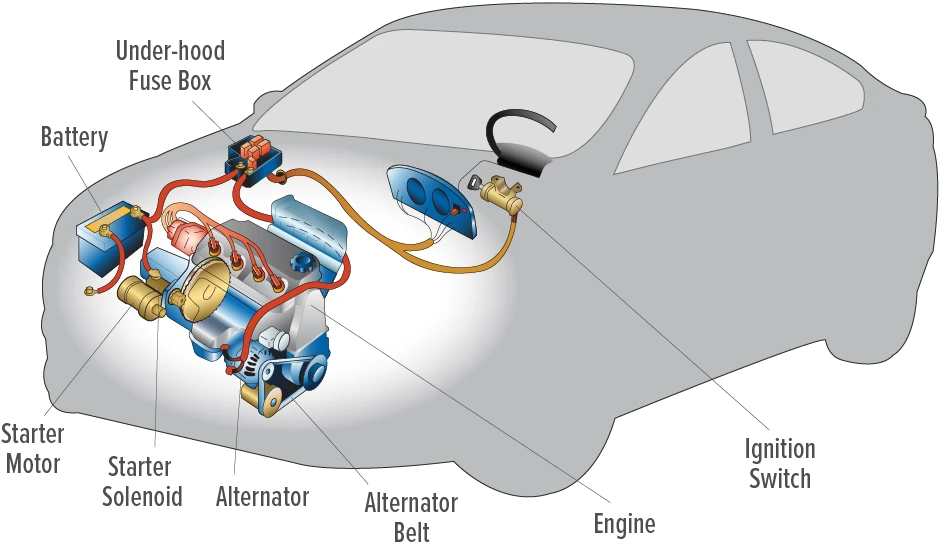
If Your Car Still Won’t Start, Stop by Les Schwab
Diagnosing battery and alternator issues isn’t always easy. If you’re experiencing any of these issues, get your vehicle to Les Schwab for a free inspection and some solid advice. Our trained technicians have the tools and experience to pinpoint the issue fast. That includes inspecting your battery fluid level, the posts (the terminals marked + and -) for corrosion, and cables for snug connections, as well as measuring the voltage and cold cranking amps (CCA) along with your alternator’s voltage and current output.
Schedule A Free Battery Check Schedule A Free Battery Check -
How to Disconnect and Connect a Car Battery Safely and Easily
The 12-volt battery in your vehicle is essential, whether you drive a gas-powered or electric car. When that battery starts to go bad, getting a new one can help keep you from getting stranded. Removing the old and connecting a new battery to your car can require special care, equipment, and step-by-step directions to get it done right, including which terminal to disconnect first. Here’s what you need to know about replacing a car battery and how to avoid damaging the electronics, transmission, and engine in your vehicle when you do it.
Les Schwab has been installing new batteries for decades. If you drive a newer vehicle with a lot of electronics, stop by any location and have your new battery installed correctly.
Before You Get Started: Consider These

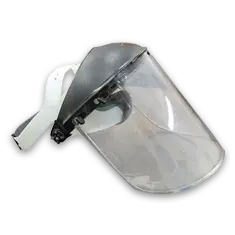
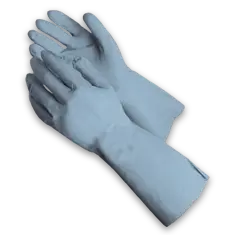

Safety
Batteries are filled with corrosive materials that can cause considerable damage to people and property. When Les Schwab professionals remove and install batteries, they often wear eye and face protection, as well as gloves. If a battery is leaking, our professionals will also wear protective aprons. Following these same safety guidelines can help protect you as well.
Battery Type
The type of battery you need depends on what you drive. Refer to your owner’s manual for the battery size or group, battery type, as well as the minimum cold cranking amps required for your car or truck. Getting the wrong battery can cause power issues, including stalling your engine and shutting off safety features. The professionals at Les Schwab can show you all of your battery options and help you make the right choice.
Tools and Equipment
Besides safety equipment, you’ll need a wrench to disconnect the terminals, as well as a towel to protect the side of your vehicle from damage. Need help with your battery? Les Schwab has the tools and equipment to get yours done right.
Your Owner’s Manual
Inside your owner’s manual, you’ll find detailed information about the proper steps to remove and replace your car battery. If those directions require a battery saver as well as initializing your electronics once the installation is complete, bring your vehicle to Les Schwab. We have all the right tools and the know-how to get it done right. Removing or installing a battery incorrectly can result in the loss of your entertainment system presets, air-conditioning functionality, and ADAS (Advanced Driver Assistance Systems). It can also affect your transmission and engine.
Book Your Appointment Book Your Appointment
How to Correctly Disconnect a Car Battery
1. Turn Off the Engine
Once the engine is off, remove the key and place it at least 15 feet from the vehicle. If your vehicle has a proximity key that detects your vehicle, this will keep it from talking to your car’s computer during installation.
2. Wait 10 Minutes
This gives your car’s computer enough time to properly shut down. Disconnecting the battery before that computer is off could damage your vehicle’s computer system.
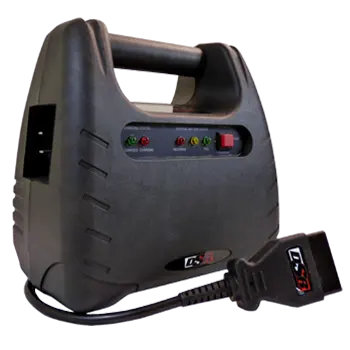
3. Connect a Memory Saver
These devices connect to your car’s OBDII port, often found under the dash behind the steering wheel. This is the same port used to diagnose a car or check its emissions. Without a battery saver installed, you could experience voltage spikes, which could damage your power windows, disable safety features, and cause your transmission or engine to function improperly.
Les Schwab uses a memory saver on every vehicle that requires it.4. Locate the Battery and Terminals
Once you’ve located the battery in the engine compartment, under the back seat, under the passenger seat, or in another location, look for the black negative (-) and red positive (+) terminals. Still not sure which terminal is which? If the + and – symbols are not legible and the positive cable is not covered in a red hood, there is another way to possibly spot the two different terminals. The positive post often has a bigger diameter than the negative post. However, be sure before disconnecting or reconnecting any posts on your vehicle.
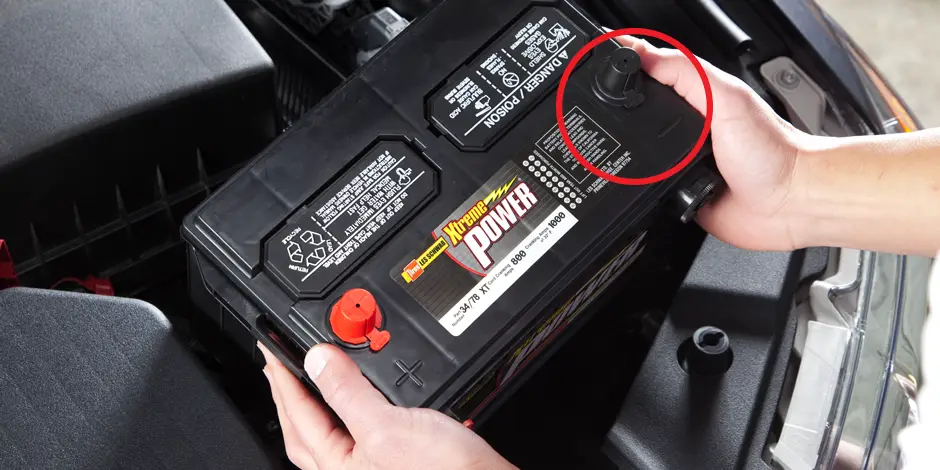
5. Disconnect the Negative Terminal
Start by disconnecting the negative (-) terminal. This might require a wrench. Set the cable aside on a towel or place it inside a tennis ball with a slit added to one side. This will ensure the cables don’t touch metal and cause issues.
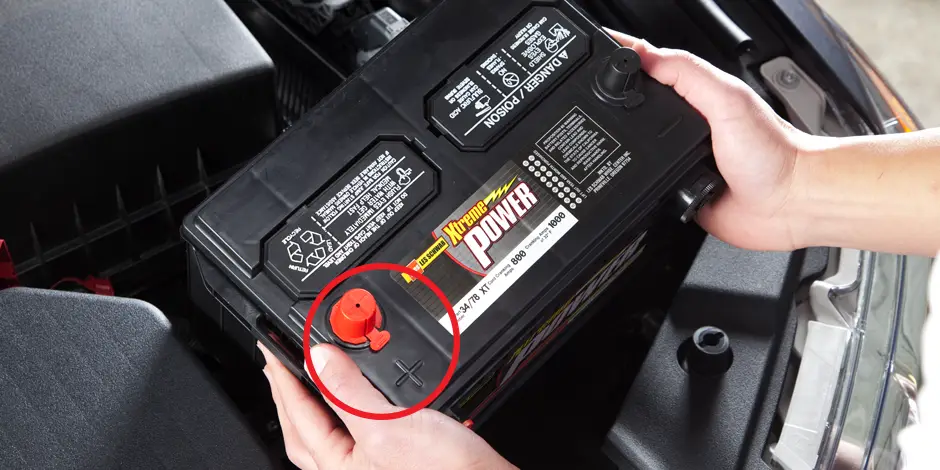
6. Disconnect the Positive Terminal
Using a wrench, disconnect the positive terminal. Place that cable on a towel or inside a tennis ball as well.
7. Loosen and Remove the Battery Hold-Down
Most vehicles will have a battery hold-down or bracket system to keep the battery in place while driving. Loosen the fasteners and remove the hold-down from atop the battery.
8. Remove the Car Battery
A battery can weigh upwards of 40 pounds, so lift carefully. Always lift the car battery straight out of the compartment. If you need a second person to help, be sure they also wear protective equipment.
Does your battery simply need to be charged up? Les Schwab does it for free with your Les Schwab battery warranty.
How to Connect a Car Battery Correctly
1. Inspect and Clean the Terminals
Over time, corrosion can build up on a battery and your vehicle’s terminals. With the old battery out, clean the terminals to avoid adding corrosion to the new battery and reducing its overall lifespan.
2. Install the Battery
Carefully place the new battery into the battery box and reinstall the hold-down.
3. Reconnect the Terminals
First, connect the red or positive (+) terminal. While that is being installed, leave the black or negative (-) cable safely in the towel or tennis ball. Once the positive is installed, attach the negative cable.
4. Tighten the Bolts
Using a wrench, ensure both the positive and negative cables are secure and tight. Do not touch your wrench to any metal in your vehicle while tightening the bolts to avoid damaging the battery or your vehicle.
5. Register the Battery and Your Electronics
Using the OBDII port and a special battery registration device, you can now register your new battery. This helps ensure the computer systems in your vehicle do not overcharge the new battery, which can damage it and the electronics in your vehicle. Additionally, registration allows you to reset the electronics in your vehicle, including the windows, sunroof, remote locks, and seat presets, as well as ADAS and other safety systems.
The professionals at Les Schwab have the tools to register your battery and reset the electronics in your vehicle. Book your appointment now.6. Test the Battery
Once the battery is installed properly and registered, it’s time to give it a test. As long as your car starts and everything works as expected, the battery has passed.
Don’t like to take chances with your battery? Get to Les Schwab. We’ll remove your old battery, install the new one, and send you home with a Les Schwab Battery Warranty.
Trust Les Schwab for Your Battery Needs
All of your battery answers and expert installation are at Les Schwab. When you buy your battery from us, you’ll get free battery checks and free charging services when you need them — all at no extra cost.
Book Your Appointment Book Your Appointment -
What To Do When The Car Battery Light Comes On
The lights on your dashboard can tell you some important information about your vehicle. When you see the battery light on in your car, it’s letting you know there is an issue with your battery or electrical system. Here’s what you need to know about that warning and how to pinpoint the issue.
Please Notice! Batteries can be dangerous. They contain sulfuric acid and can cause injury. We recommend wearing appropriate safety equipment before working on your car battery. This includes protective glasses and gloves. Additionally, avoid wearing baggy clothing or metallic jewelry while inspecting or cleaning your battery.
About Electric Vehicles
While every vehicle, including EVs, has a 12-volt battery, the battery in an EV works differently. If a 12-volt battery in an EV is dead, it won’t start the vehicle. It also won’t make any clicking noises. See the professionals at Les Schwab for an annual checkup of your EV’s 12-volt battery to ensure you’re not left stranded.
What Does It Mean When Your Battery Light Comes On?
In a gas-powered vehicle, the 12-volt battery helps start the vehicle. Once it’s started, the alternator recharges the battery and helps keep your electrical systems working.
When that light comes on and stays on, and you notice that your power windows are sluggish or your vehicle has a hard time starting, it could be an issue with your alternator. It can also be the voltage regulator, a loose battery cable, corrosion on the battery or cable, a weak battery, or an electrical issue somewhere in your vehicle.
Learn more about car batteries and how they work from the Les Schwab professionals.

Understanding The Battery Light
When the battery light appears on the dash of your gas-powered or EV vehicle, it can indicate a loose cable, bad wiring, or a dying battery. In gas-powered vehicles, it can also be an alternator issue. Or it might be nothing. If the indicator goes away after a few minutes or disappears after you restart your vehicle, there’s likely nothing to worry about.
The times you do need to worry about that battery alert include:
- Weak battery: The battery is not holding a charge and has trouble starting your vehicle.
- Failing battery: Eventually, every car battery needs to be replaced. As a battery gets older, it becomes more difficult for them to hold a charge. If your battery is more than five years old, it may be time to get a new one.
- Faulty alternator: If this is not working properly, the battery cannot be recharged and will quickly die. Alternator issues can include broken or damaged belts.
- Loose or corroded battery connections: A loose connection or corrosion can damage the battery and/or drain it. Check your battery cables often. If you find any loose cables, tighten them. If you find any corrosion, clean it off to ensure a tight connection. Learn how to remove corrosion from your battery.
- Electrical system issues: These problems can include faulty voltage regulators or wiring. This is often the job for a professional, unless you like working under the dash to trace wires back to their origin and fuse.
How Long Can You Drive With the Battery Light On?
When your battery light comes on while driving, you may be running primarily on battery power without it being recharged by the alternator. This means your vehicle could stop running at any time, depending on your battery’s overall health. To play it safe, drive directly to your local Les Schwab or safely pull over and arrange for assistance.
Steps To Take If The Battery Light Turns On
Most of the time, the cause of the battery light is an easy fix. The professionals at Les Schwab are happy to give your battery a free visual inspection. Want to check things on your own? Grab your safety gear and try these quick tips.
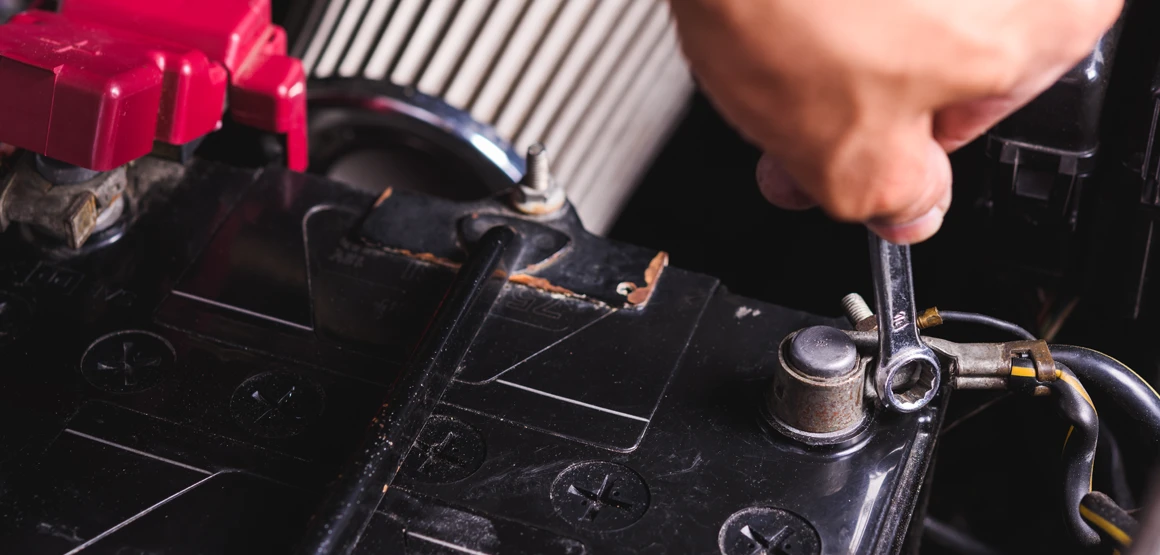
Look for loose connections. Check the connection where the terminals attach to the battery posts. Are they loose? If so, tighten them up.

Look for corrosion. If you find corrosion, a white powdery substance that forms on battery posts and terminals, clean it off. Here is some advice on how to remove corrosion from your battery.

Check your battery voltage. If your 12-volt battery reads less than 11.8 volts, you have a dead battery that either needs to be replaced or recharged. Need help checking the voltage on your car’s 12-volt battery? Stop by Les Schwab for a quick battery check.
Troubleshooting The Battery Light
- Test the alternator output: A healthy alternator should produce anywhere from 13.5 to 14.5 volts when the engine is running. Lower readings could indicate alternator problems.
- Check for damaged wiring: Inspect visible wiring for fraying, melting, or other damage.
- Examine the serpentine belt: On gas-powered vehicles, look for cracks, glazing, or looseness that would prevent proper alternator function.
- Test for power drains: Excessive power draw when the vehicle is off could indicate an electrical problem.
If the battery indicator is still on and you’ve tightened the cables, cleaned the corrosion, and checked the battery power, the next step is to stop by Les Schwab. We carry batteries for nearly everything you drive and offer free battery charging and free battery checks. If you need a new battery, we’ll remove the old one, clean up the cables, and install the new one. It’s our way of keeping you from getting stranded on the side of the road.
Signs Your Car Battery Is About to Die
Watch for these warning signs that your battery is nearing the end of its life:
- Slow engine crank: Your engine takes longer than usual to start.
- Dimming headlights: Especially noticeable when idling.
- Electrical component issues: Power windows moving slower and radio cutting out.
- Battery light coming on intermittently: Flickering dashboard lights.
- Swollen battery case: Physical deformation of the battery.
- Unusual odor: A rotten egg smell from the battery area.
- Multiple jump-starts needed: Does it take more than one jump to get things going?
Preventing Future Battery Issues: Professional Tips and Maintenance Schedule
Les Schwab is here to help you recognize the signs of a bad or dying battery, including the effects of cold and hot weather on that 12-volt bit of automotive wonder. To prevent future battery issues:
- Have your battery tested twice a year before extreme seasonal changes.
- Schedule a free pre-trip safety check, which includes a visual inspection of your battery.
- Consider upgrading to a higher-capacity battery if you frequently use multiple electronic accessories.
- Keep your battery connections clean and tight.
- Clean your car battery if you find any corrosion.
FAQ: Battery Light Questions Answered
Can a bad battery damage my alternator?
No. A bad or dying battery will not likely damage an alternator. But a faulty battery might not be rechargeable, meaning you could be left stranded when the battery dies (even if you get your car jump-started).
How much does a car battery replacement cost?
Car and light truck batteries range in price depending on the size and type of battery you need. Additionally, there may be a charge to install a new battery. Our professionals have been installing and maintaining batteries for decades, including batteries for motorcycles, RVs, boats, farm equipment, and more.
Can I jumpstart a car with the battery light on?
Yes. Jump-starting a vehicle with a battery light indicator on the dashboard is possible. However, if there is an issue with the alternator, or if the battery is dead or dying, your vehicle might not run for long. Get to your local Les Schwab anytime the battery light appears on your dashboard and our professionals will run a quick diagnostic on your battery and alternator.
Why does my battery light flicker occasionally?
When the battery light on your dashboard flickers it could be one of several things. These include a dead or dying battery, a loose connection, corrosion buildup, a faulty alternator, or an issue with your vehicle’s electrical system.
How often should I replace my car battery?
This varies depending on where you live and what you drive. Most batteries are warranted for up to five years. Batteries that are older than three years should be checked at least twice a year.
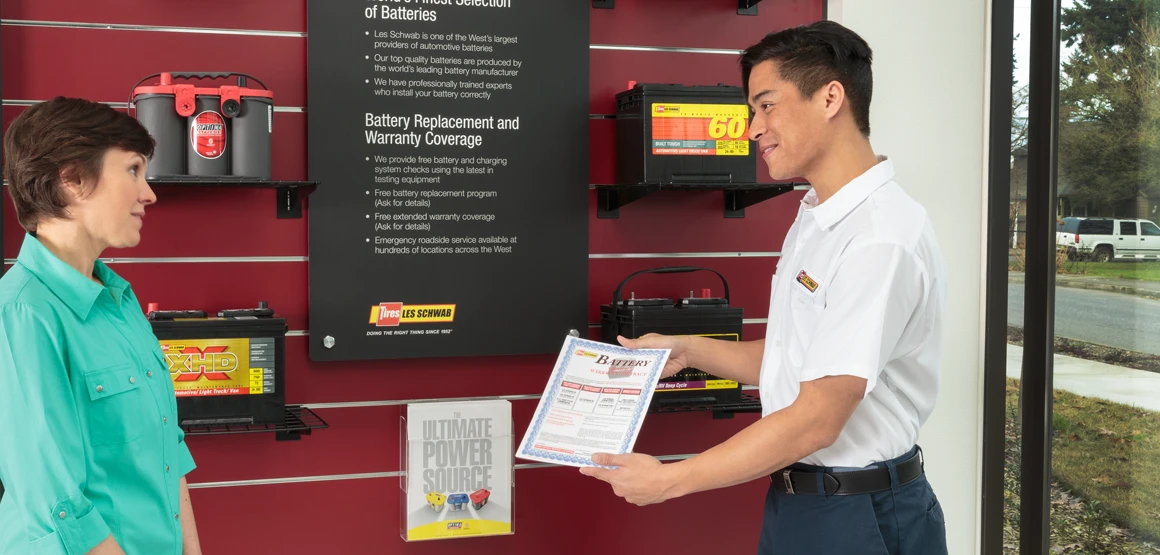
Les Schwab: Your Battery Experts
At Les Schwab, we’re dedicated to ensuring your vehicle’s battery is in optimal condition. When you buy your battery at Les Schwab, you’re covered for years beyond industry standards. That includes free battery and charging system inspections, free battery charging, and a free battery warranty you don’t pay extra for.
Don’t let battery troubles leave you stranded. Visit Les Schwab for reliable battery services.
Find a Store Find a Store Book Your Appointment Book Your Appointment
Opens warranty information dialog with language options
